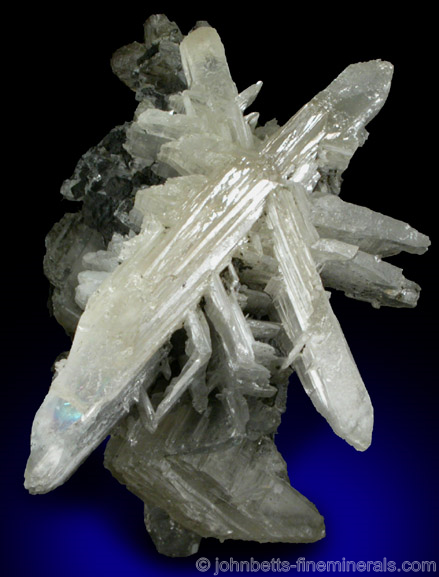The Mineral cerussite

Cerussite is an interesting mineral, forming in an array of fascinating crystal formations and bizarre twinning habits. It is easily identifiable by its heavy weight, brilliant luster, and crystal habits. Cerussite also performs interesting reactions during blowpipe testing. Specimens may be fragile and should be handled with care.
Color
Colorless, white, cream, light gray, light yellow, and brown. May also be lightly tinted blue, green, or red.
Crystal System
Orthorhombic
Properties
Streak
White |
Hardness
3 - 3.5 |
Transparency
Transparent to translucent |
Specific Gravity
6.5 - 6.6 |
Luster
Greasy to adamantine. Fibrous growths, which are rare, may be silky. |
Cleavage
1,1 - prismatic |
Fracture
Conchoidal |
Tenacity
Brittle |
Other ID Marks
Commonly fluorescent, usually cream-white to yellow in shortwave ultraviolet light |
Crystal Habits
Cerussite forms some of the most interesting, complex, and varied crystals and groupings in the mineral kingdom. Its most prevalent form is as small, flat, thin plates, as well as prismatic and tabular crystals. Crystals frequently twin to form interesting shapes, such as star, heart, sixlings, and v-shaped twins. A highly coveted form is reticulated growths of thin crystals which form a delicate, snowflake-like mass. Also reticulated, acicular, radiating, coxcomb, in wheat sheaf form, fibrous, and massive. Crystal faces are usually striated.
Uses
Cerussite is an important ore of lead. It is also a popular mineral among collectors, especially when it forms attractive twinned crystals. Cerussite from certain locations is rich in silver thus may be used as a minor silver ore. Cerussite was once used as a white pigment. It is occasionally faceted into gems for collectors.
Noteworthy Localities
Large single Cerussite crystals, as well as v-shaped twins and intergrown "snowflakes," were found at Tsumeb, Namibia, which is a classic locality for this mineral. Fine crystals have also been abundant in Morocco at Mibladen and Touissit. In Australia, excellent Cerussite specimens have come from Broken Hill, New South Wales; and the Rum Jungle, Batchelor, Northern Territory. Many fine crystals have come from Motevecchio and Monteponi, Sardinia, Italy; Weardale, North Pennines, Durham, England; the Pentire Glaze Mine, St Minver, Cornwall, England; and the Nakhlak Mine in Esfahan Province, Iran.
In the U.S., large, single Cerussite crystals occur in the Organ Mountains of Dona Ana Co. and in the Magdalena District, Socorro Co., New Mexico. In Idaho, crystals have been found at the Kellogg and Monarch Mines, Coeur d'Alene, Shoshone Co. Fine specimens have come from numerous Arizona localities, particularly the Tiger Mine, Globe, Gila Co.; the 79 Mine in Hayden, Gila Co.; the Mammonth-St. Anthony Mine in Tiger, Pinal Co.; and Bisbee, Cochise Co. Fragile white crystals in spiky masses were found in the Flux Mine in Patagonia, Santa Cruz Co., Arizona. Cerussite was once found in the Wheatley Mines of Phoenixville, Chester Co., Pennsylvania.
Distingushing Similar Minerals
Aragonite - Lighter in weight, less brilliant in luster, and strongly effervesces in hydrochloric acid.
Anglesite - Doesn't effervesce at all in hydrochloric acid or dissolve in nitric acid, and never forms twinned crystals. Otherwise very difficult to distinguish.
Phosgenite - Softer, occurs in different crystals, fluoresces bright orange.
Hemimorphite - Harder , not as heavy.